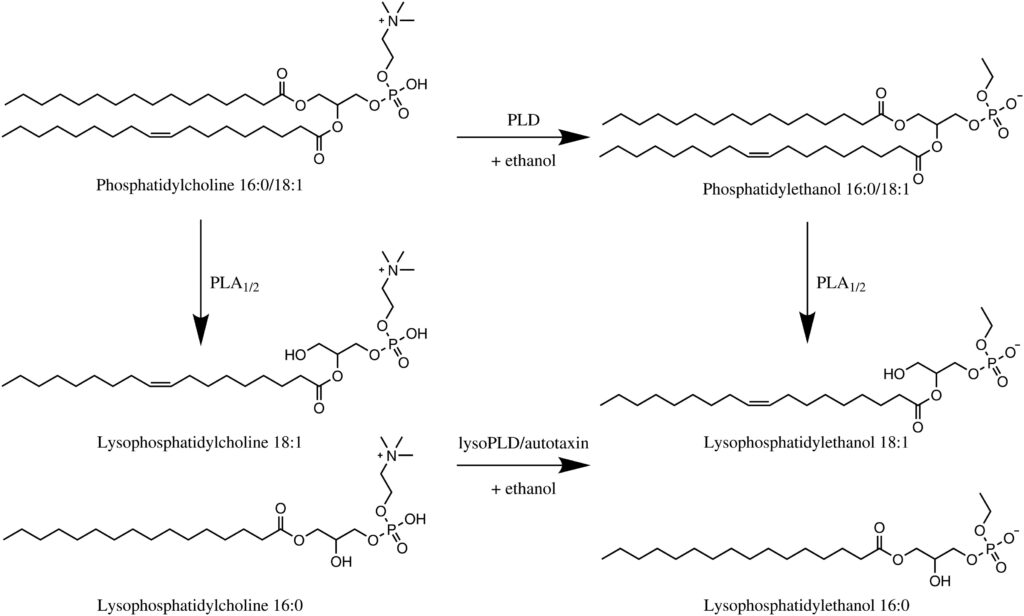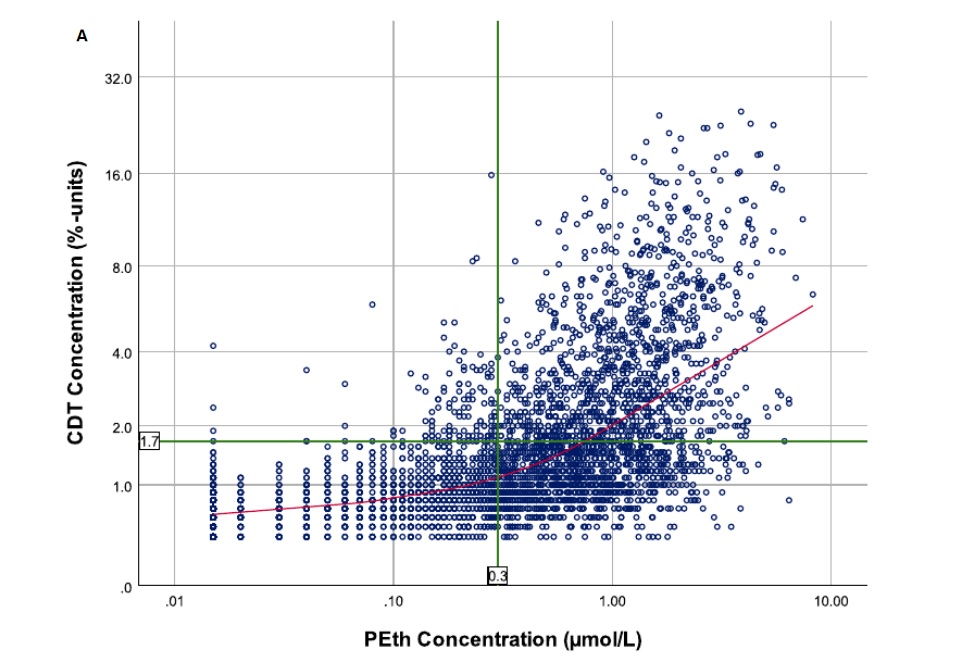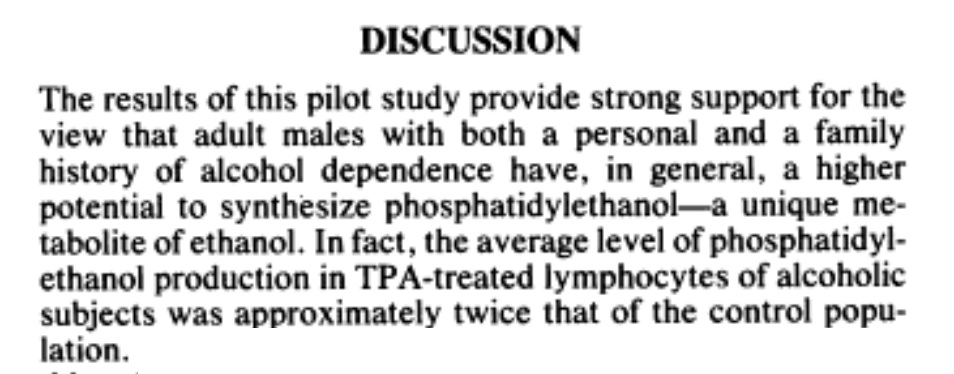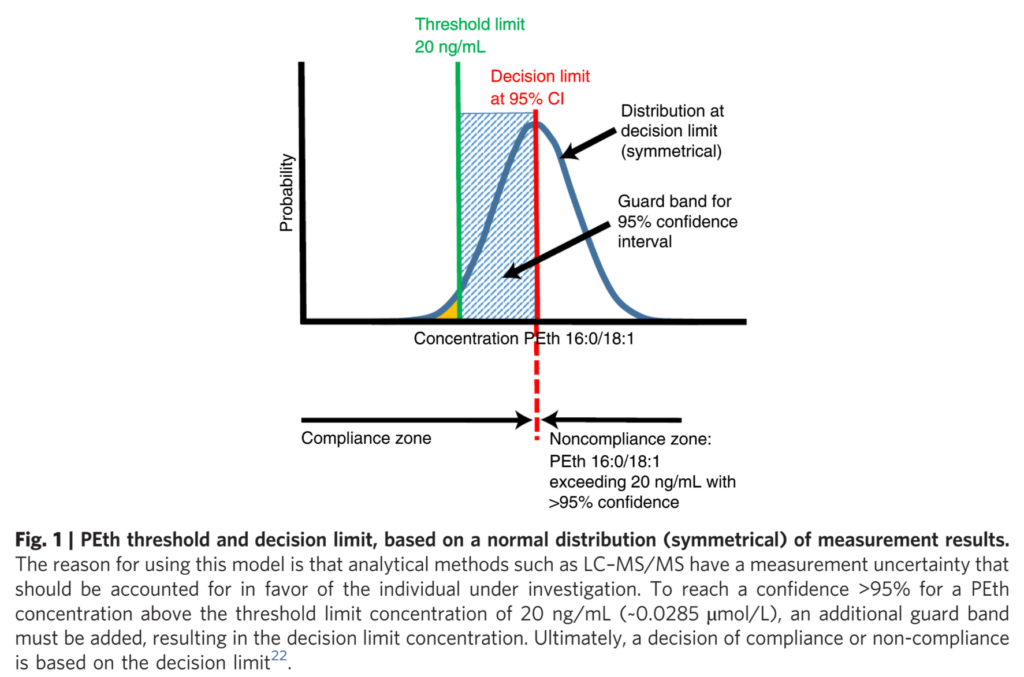19th of December
GPs’ experiences of phosphatidylethanol in treatment of hypertension: a qualitative study
Thurfjell et al. just published an article in BJGP Open.
They found that PEth is a useful tool that changed GPs’ routines for addressing alcohol and identifying hazardous alcohol use in patients with hypertension managed in primary healthcare. The GPs advocated adopting PEth as a routine test in the treatment of hypertension.
16th of September
Lyso-phosphatidylethanol detected by LC-MS/MS as a potential new marker for alcohol consumption
Bantle et al. just published an article in the European Journal of Mass Spectrometry.
They present a new sub-class of yet unknown PEth species, LysoPEths, which are structurally related to PEth, but miss one fatty acyl chain.

29th of August
Stability of PEth 16:0/18:1, 16:0/18:2, 16:0/20:4, 18:0/18:1, 18:0/18:2, and 18:1/18:1 in authentic whole blood samples (at room temperature)
Aboutara et al. just published an article in the journal Drug Testing and Analysis.
They state that, “due to the high scatter of stability among the samples and the observed poor stabilities in some, it can be concluded that transportation and storage times, especially if cooling cannot be provided, must be kept short. If analyzing from dried blood, spotting should preferably be conducted at the site of sampling.”
28th of August
Miniature mass spectrometer-based point-of-care assay for measuring phosphatidylethanol in blood
Pandey et al. just published an article in the journal Analyst.
“They demonstrate a proof-of-concept for point-of-care assessment of long-term alcohol consumption by measuring phosphatidylethanol in blood/dried blood spots with nano-electrospray ionization and MS/MS using a miniature mass spectrometer.”
28th of August
“But I didn’t drink!”: What to do with discordant phosphatidylethanol results
Winder et al. just published an article in the journal Liver Transplantation.
“The article discusses the general toxicological properties of PEth; explores possible scenarios of concordance and discordance among PEth results, patient history, and self-reported drinking; and provides detailed clinical communication strategies to explore discordance with liver patients, a key aspect of its use.“
21st of August
Monitoring of phosphatidylethanol in dried blood spots and of ethyl glucuronide in hair over 6 months of alcohol consumption
Herzog et al. just published an article in the journal Drug Testing and Analysis.
They state that out of 23 investigated volunteers, “two participants exceeded the threshold for PEth 16:0/18:1 of 210 ng/mL in blood but remained below 30 pg EtG/mg hair. PEth showed a higher detection rate for alcohol consumption than EtGH did. Moreover, PEth concentrations reacted quickly to changes in drinking behavior, whereas EtGH concentrations remained similar over time.”
31st of July
The complementarity of phosphatidylethanol in whole blood and ethyl glucuronide in hair as biomarkers for the monitoring of alcohol use
Dumitrascu et al. just published an article in the journal Drug Testing and Analysis.
They state that “the insights gained from this study are useful particularly when interpreting the results in medico-legal contexts, such as liver transplantation procedures, gastrointestinal and cardiovascular diseases, injuries and driving licence regranting. The two biomarkers, PEth 16:0/18:1 in whole blood and hEtG, are complementary, as one detects the changes in drinking habits in the last 2–4 weeks (PEth 16:0/18:1), which could be missed by mere analysis of hEtG that shows the alcohol consumption over a long period.“
26th of July
Increasing Confidence in a Phosphatidylethanol 16:0/18:1 Cutoff at 20 ng/mL to Support Abstinence or Minor Intake of Alcohol
Katleen Van Uytfanghe and Christophe Stove from the University of Ghent, Belgium just published a letter to the editor in the Journal Clinical Chemistry.
In their letter, they describe validation of the 20 ng/mL cutoff, based on data from a unique large-scale study, utilizing a prediction model to evaluate claims of abstinence. They conclude that the the high specificity of PEth “objectively supports the use of the PEth 20 ng/mL cutoff to score with high confidence “compatibility with abstinence or minor alcohol intake” following claims of 4 or more weeks of abstinence.”
25th of April
Development and Validation of an LC-MS/MS Method to Quantify the Alcohol Biomarker Phosphatidylethanol 16:0/18:1 in Dried Blood Spots for Clinical Research Purposes
Salah et al. just published about the development and validation of a PEth assay for clinical research. The team successfully validated their assay using the PEth-NET inter-laboratory comparison samples:
“Target concentrations for the four samples quantified in the EQA were as follows according to The Society of PEth Research: 45 ± 11, 371 ± 67, 188 ± 38, and 17 ± 5 ng/mL. We quantified all samples within this range and without outliers, at 53, 395, 197, and 14 ng/mL, respectively. Our Z-scores for these samples were 0.85, 0.36, 0.24, and -0.63, respectively, demonstrating successful inter-lab comparisons of our quantification of PEth…”
The article has been published in the Journal of Chromatography B
22th of March 2023
Quantifying Alcohol Consumption in the General Population by Analysing Phosphatidylethanol Concentrations in Whole Blood: Results from 24,574 Subjects Included in the HUNT4 Study
Skrastad et al. evaluated the association between self-reported alcohol consumption and PEth concentrations in blood in a large general population study, and discuss optimal cut-off PEth concentrations for defined levels of alcohol consumption. The cut-off concentrations with highest combined sensitivity and specificity were 0.057 μmol/l (40 ng/ml) for identification of those consuming >1 alcohol unit per day (sensitivity 86%, specificity 76%), 0.087 μmol/l (61 ng/ml) for consuming >2 units per day (sensitivity 87%, specificity 81%) and 0.122 μmol/l (86 ng/ml) for consuming >3 alcohol units per day (sensitivity 80%, specificity 86%).
They conclude that cut-off limits of PEth concentrations should take into account the indication for sampling. Using cut-offs for the PEth concentrations of about 0.05 μmol/l (35 ng/ml) and 0.08 μmol/l (56 ng/ml) would identify about 90% of the subjects consuming more than 1 and 2 alcohol units per day, respectively. Concentrations above these cut-offs should lead to a more detailed interview related to alcohol use.
The article has been published in the journal Alcohol and Alcoholism
17th of March 2023
Validation of the quantification of phosphatidylethanol 16:0/18:1 concentrations in TASSO-M20 devices
Jett et al. investigated theutility, accuracy, and feasibility of using the TASSO-M20 device for blood self-collection during a virtual study. They found that the TASSO-M20 device had multiple advantages over the typical finger stick method, including consistent blood collection, participant acceptability, and less discomfort as indicated by acceptability interviews.
The article has been published in the journal Alcohol – Clinical and Experimental Research
14th of March 2023
Evaluation of Phosphatidylethanol Elimination in Alcohol Use Disorder Patients Undergoing Withdrawal Treatment
Stöth et al present a new study to evaluate the elimination time of PEth with regard to the clinically established 200 and 20 ng/ml cutoffs for PEth 16:0/18:1.
The article has been published in the journal Alcohol and Alcoholism.
14th of March 2023
Miniature mass spectrometer-based point-of-care assay for measuring phosphatidylethanol in blood
Pandey et al. demonstrate a proof-of-concept for point-of-care assessment of long-term alcohol consumption by measuring phosphatidylethanol in blood/dried blood spots with nano-electrospray ionization and MS/MS using a miniature mass spectrometer.
The article has been published in the journal Analyst.
27th of January 2022
Alcohol Biomarker Phosphatidylethanol as a Predictor of the Severity of Alcohol Withdrawal Syndrome
In their latest research article Novak et al. investigate the relationship between phosphatidylethanol (PEth) and withdrawal severity in patients with alcohol use disorder (AUD).
The article has been published in the journal Alcohol and Alcoholism.
28th of November 2022
Falsely low phosphatidylethanol may be associated withbiomarkers of haemolytic disease
In their latest research article Arving et al. discuss that falsely lower or even negative phosphatidylethanol (PEth) levels may theoretically be seen in patients with haemolytic diseases.
The article has been published in the Journal Basic and Clinical Pharmacology and Toxicology.
24th of November 2022
Haematocrit correction of whole blood phosphatidylethanol (PEth) concentrations to estimate erythrocyte PEth concentrations: sensitivity, specificity and influence on test utility
In their latest Technical Note White et al. investigated whether erythrocyte PEth might be validly calculated by haematocrit correction of a whole blood PEth measurement. They concluded that haematocrit-correction of whole blood PEth concentrations provides an alternative to preparation of washed erythrocytes.
The article has been published in the Journal of Analytical Toxicology.
7th of November 2022
Development and validation of seven phosphatidylethanol-homologues in dried blood spots including preliminary results after excessive use of an ethanol-based hand sanitizer
Herzog et al. from the FTC Munich published a study investigating the impact of PEth formation during the excessive use of an ethanol-based hand sanitizer. They conclude, that in cases of regular alcohol consumption, PEth-homologues are not likely to be further influenced by hand sanitizers.
The study has been published in the Journal of Analytical Toxicology.
24th of October 2022
PEth 16:0/18:1 and 16:0/18:2 after consumption of low doses of alcohol – A contribution to cutoff discussion
Aboutara et al. published a study investigating PEth 16:0/18:1 and PEth 16:0/18:2 in 75 participants who drank 20 g of alcohol on three consecutive evenings. They suggest that PEth cut‐off concentrations should be lowered for better detection of consumption of low to medium amounts of alcohol. Furthermore, they found it advantageous to analyze both PEth 16:0/18:2 and 16:0/18:1. The study is published in the journal Drug Testing and Analysis.
21st of October 2022
Can PEth be Detected with a Cutoff of 20 ng/mL after Single Alcohol Consumption?
Stöth et al. studied the amount of blood alcohol concentration that is needed in order to reach the 20 ng/mL cutoff for PEth 16:0/18:1 during a drinking study with twelve volunteers that have been abstinent for four weeks.
Despite drinking doses up to 0.58 g ethanol per kg body weight and reaching BACs of up to 0.63 g/kg, PEth 16:0/18:1 and PEth 16:0/18:2 could not be detected at or above the 20 ng/mL cutoff in any participant at any time after the drinking events. They conclude that after long-term abstinence the cutoff of 20 ng/ml for single alcohol consumption leading to blood alcohol concentrations up to 0.63 g/kg is not exceeded. The article is published in the Journal of Analytical Toxicology.
7th of September 2022
False Positive Results of Phosphatidylethanol (PEth) Quantitation in Dried Blood Spots (DBS): The Influence of Alcohol Vapors
Bashilov et al. from Moscow, Russia, investigated the influence of alcohol vapors regarding false positive results of phosphatidylethanol (PEth) quantitation in dried blood spots (DBS).
The article is available as open access publication by following this link.
10th May 2022
Validation of a liquid chromatography tandem mass spectrometry (LC-MS/MS) method for erythrocyte phosphatidylethanol revealing critical considerations for its use as a clinical biomarker
In this novel research paper, White et al. describe an assay for erythrocyte PEth 16:0/18:1. It is available in the Journal of Chromatography B.
10th May 2022
Positive blood phosphatidylethanol concentration is associated with unfavorable waitlist-related outcomes for patients medically appropriate for liver transplantation
A novel study This study examined the association of PEth results with liver transplantation waitlist-focused patient outcomes. It is available in the journal Alcoholism – Clinical and Experimental Research
9th May 2022
Availability of PEth testing is associated with reduced eligibility for liver transplant among patients with alcohol-related liver disease
This novel study investigated whether the availability of PEth testing impacted rates of liver transplant evaluation terminations and delistings. It is available in the journal Clinical Transplantation.
14th February 2022
Current evolutions, applications, and challenges of phosphatidylethanol analysis for clinical and forensic purposes
A novel overview about “current evolutions, applications, and challenges of phosphatidylethanol analysis for clinical and forensic purposes” is available now at WIREs Forensic Science. The aim of the overview is to lead the way for PEth harmonization together with the PEth in Mind conference in May 2022.
13th February 2022
Novel US-Patent for quantifying phosphatidylethanol from blood samples using gas chromatography mass spectrometry
In collaboration with the Loyola University of Chicago, James Vincent DeFrancesco (Arlington Heights, IL) and Majid Afshar (Chicago, IL) issued a novel patent for the determination of PEth using gas chromatography (patent number: 11085939).
25th January 2022
A positive test result for the alcohol biomarker phosphatidylethanol can still be used to underpin short-term abstinence
PEth-NET members Katleen van Uytfanghe and Christophe Stove just published about the “Set-up of a population-based model to verify alcohol abstinence via monitoring of the direct alcohol marker phosphatidylethanol 16:0/18:1” in the journal Addiction.
2nd December 2021
Phosphatidylethanol in patients with liver diseases of different etiologies: Analysis of six homologues and comparison with other alcohol markers
Nadine Aboutara et al. published novel research in Clinica Chimica Acta.
Highlights
•Sensitivity of uEtG, hEtG and CDT for drinking alcohol in the past 3 months was 29%
•PEth 16:0/18:1’s sensitivity was 53% for alcohol consumption in the past 3 months.
•For consumption of seven standard drinks per week PEth’s sensitivity was 92%.
•Quotients of some PEth-homologues were smaller if alcohol uptake was more recently.
•In 50% of the patients who stopped alcohol uptake 4 weeks prior, PEth was positive.
29th July 2021
Factors associated with phosphatidylethanol (PEth) sensitivity for detecting unhealthy alcohol use: An individual patient data meta-analysis
Judy Hahn et al. just published a meta-analysis in the Journal Alcoholism, Clinical & Experimental Research. They report, that age, sex, and the method of blood collection were not associated with PEth sensitivity. However, several biological factors (hemoglobin, BMI, liver fibrosis, and HIV status) were associated with PEth sensitivity. Race/ethnicity was associated with PEth sensitivity in some models. Overall they conclude, that researchers should consider adjusting analyses for these characteristics where possible.
27th May 2021
Comparison of the Diagnostic Value of Phosphatidylethanoland Carbohydrate-Deficient Transferrin
Alexander Arving et al. compare the diagnostic value of Phosphatidylethanol and Carbohydrate-Deficient Transferrin (CDT) as biomarkers of alcohol consumption in their latest article (available for free) published in Alcoholism: Clinical and Experimental Research.

20th April 2021
Hematocrit Corrected PEth Analysis
The article “Fully Automated Correction for the Hematocrit Bias of Non-Volumetric Dried Blood Spot Phosphatidylethanol Analysis” is now available in the journal Alcohol.
An explanatory video is available on youtube:
11th March 2021
Old but gold…?

16th February 2021
PEth post sampling formation from ethanol
In their latest publication, Olof Beck, Maria Mellring, Christian Löwbeer, Sabina Seferaj & Anders Helander investigated the post-sampling formation of PEth in various devices for blood microsampling.
they found that:
“with three commercial devices for volumetric dried blood microsampling, which is considered important for use in test applications needing precise substance quantification [41, 42], post-sampling formation of PEth from ethanol was observed with all of them (Mitra, Capitainer, Hemaxis), albeit to varying degrees, upon drying and storage at room temperature.”
They investigated that pretreatment of the DBS sampling substrate with an inhibitor (NaVO3) can stop the formation of PEth
No PEth formation was observed when blood spiked with ethanol at a physiologically relevant concentration (2 g/L) was added to Protein Saver card filters.
The article is published in Analytical and Bioanalytical Chemistry and is freely available by following this link.
4th January 2021
Quantitation of phosphatidylethanol in dried blood after volumetric absorptive microsampling
In their latest publication, Katleen Van Uytfanghe, Maria Del Mar Ramirez Fernandez, Aurelie De Vos, Sarah MR. Wille and Christophe Stove present the application of PEth analysis in Belgium, at the Ghent University’s Laboratory of Toxicology and the National Institute of Criminalistics and Criminology .
Congratulations on the successful initiation of a Belgian network for quantifying phosphatidylethanol 16:0/18:1.
The article is published in Talanta and is freely available by following this link.
8th December 2020
Protocol for PEth DBS Analysis
A protocol for the analysis of PEth in DBS (manually or automated) has been published by Springer-Nature in the Journal “Nature Protocols”.
The article is freely available follwing this link:

Highlight, 6th November 2020
The Importance of Regioisomeric Purity in PEth Reference Material
In their publication, Marc Luginbühl, Reuben S E Young, Frederike Stöth, Wolfgang Weinmann, Stephen J Blanksby, and Stefan Gaugler show the importance of the right choice of reference material for reliable PEth research.
“The results suggest caution in ensuring the regioisomeric composition of reference materials are well-matched with the authentic blood samples.”
The article is published in the Journal of Analytical Toxicology and can be found following this link: https://pubmed.ncbi.nlm.nih.gov/32248226/
4th November 2020
Stability of Phosphatidylethanol 16:0/18:1 in Freshly Drawn, Authentic Samples from Healthy Volunteers
In their latest publication, Ragnhild Bergene Skråstad, Olav Spigset, Trond Oskar Aamo and Trine Andreassen challenge current knowledge about PEth storage and stability.
Within their novel publication they state “PEth 16:0/18:1 is stable for 28 days irrespective of storage temperature”
The article is published in the Journal of Analytical Toxicology and can be found following this link: https://pubmed.ncbi.nlm.nih.gov/32754728/
6th October 2020
Testing venous CDT or capillary PEth with concurrent EtG and EtPa hair tests to assess historical and recent alcohol use
In their latest publication, L. Tsanaclis, M. Davies, S. Bevan, J. Nutt, K. Bagley and J. Wicks compare direct (EtG, FAEE, PEth) and indirect (CDT) alcohol biomarkers either measured in hair or blood.
The results of the study “substantiate the case for using hair EtG in conjunction with a PEth test, rather than CDT test, for efficient monitoring of recent and historical alcohol consumption.”
The article is published in Drug Testing and Analysis and can be found following this link: https://doi.org/10.1002/dta.2939
